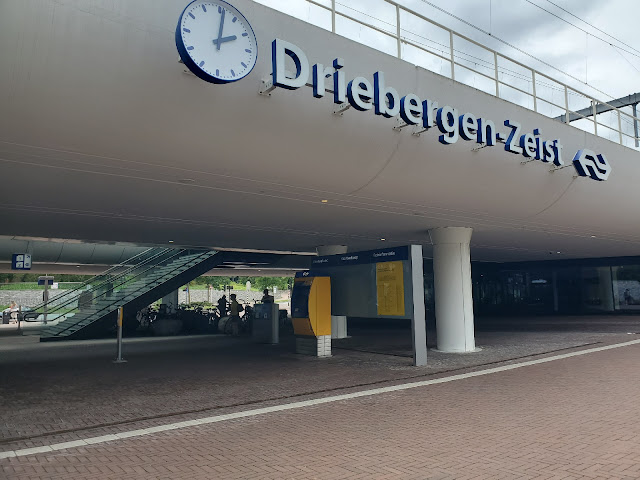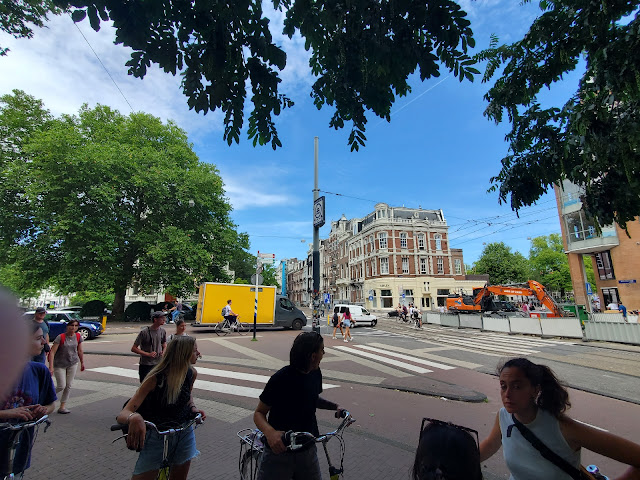Mobility Hubs
In an earlier post, I mentioned how in designing a complete sustainable transportation system, we must design to integrate various modes of sustainable transport rather than focusing solely on one effective mode. Today, we had an opportunity to learn more about how biking and transit work together in the Netherlands. Our instructor is an ex-pat from the United States, who first lived in Southern California, worked as a planner in Hawaii, and now lives in the Netherlands working for a public transit company. Bradley, our instructor for this afternoon, enlightened our group about how bicycle transport has integrated with the regional and inter-city rail services found in the country. Some of my classmates biked from Utrecht to our destination, the community of Zeist, just a bit east of Utrecht.
I opted to train both ways to experience the rail service. Taking the Sprinter, which is the regional train between the cities nearby Utrecht, the train ride took only 11 minutes from our outbound station, Utrecht Centraal, and the destination, Driebergen-Zeist (see below).
 |
| Driebergen-Zeist station, which includes bicycle parking (left-center) and overhangs a cycle track (right) |
At the station, there are three transport modes readily available; rail, bicycling, and not pictured in the image above, buses. Bradley mentioned that the national government and municipalities required the rail company, NS, to provide bike parking at all of its stations as one way to encourage more bicycling as a commuting mode. This fact supported some of what our Utrecht guide, Ronald, told us about the regional commuting patterns of many Dutch residents. The bike functions as the front-door departure mode of transport (what is often called "the first mile" of a trip). People will bike to the train station, park their bikes, and then take the train to their destination. Upon arriving, bikes provided through the bike-share service OV-fiets allow individuals to complete their commute to the office (called the "last mile" of a trip). Parking bikes are often free for the first 24 hours, catering seamlessly to the daily commuter. With the combination of biking trips for the shorter segments and rail service to cover greater distances, an individual can live in Utrecht and commute to work in Zeist, or vice-versa.
 |
| Bike parking spaces at a station one stop from Utrecht Centraal |
Together, the bike, rail, and bus provide choices for commuters to cover larger distances and still choose to live where they wish. One difference I noted in Bradley's explanation about why this works is the integration of supportive infrastructure between the rail company and the bike mode, along with the transit providers operating the buses. In the United States, transit providers often compete with each other and this includes competition between modes. Rail ridership must stay on rail and not take buses or rent bikes from a bike-share service. Here in the Netherlands, the public transit strategy relies on the agencies seeing each as complementary to the others. And, the teeth are provided by requirements set by the government that enforces the need to provide the infrastructure to support a bike commuter arriving at the train station and the ability to rent a bike or grab a bus to complete the last mile journey. This philosophy underscores why Utrecht built, to date, the world's largest bicycle parking garage in an underground facility right next to one of the busiest rail station's in the country, Utrecht Centraal. The garage boasts over 12,500 parking spaces for bikes and is free for the first 24 hours the bike is parked there.
The last notable detail I want to mention is how fares also integrate the transport modes. A single card and fare allow one to rent an OV-fiets bike, purchase a train ticket, and pay bus fare. This integration of payments across transport modes is often referred to as Mobility as a Service (MaaS). It is uncommon in the United States, especially since most transit agencies struggle to financially support themselves. For the commuter and rider, however, it simplifies the process, saving both time and money. Pittsburgh is one of the few U.S. cities experimenting with MaaS, whereas cities such as Boston, Minneapolis, Austin, Portland, and San Diego encourage the first step in reaching MaaS, which is creating more mobility hubs supporting Mobility on Demand (MoD). What I took away from meeting Bradley and hearing about how the Netherlands supports mobility hubs is that we need to restructure our incentive systems and philosophy to not see different transit agencies as siloed and de facto competitors with one another. The more transit agencies cooperate with their service and support the infrastructure that facilities biking to provide the first-last mile trip segment, the stronger our public transit systems can become.




Comments
Post a Comment